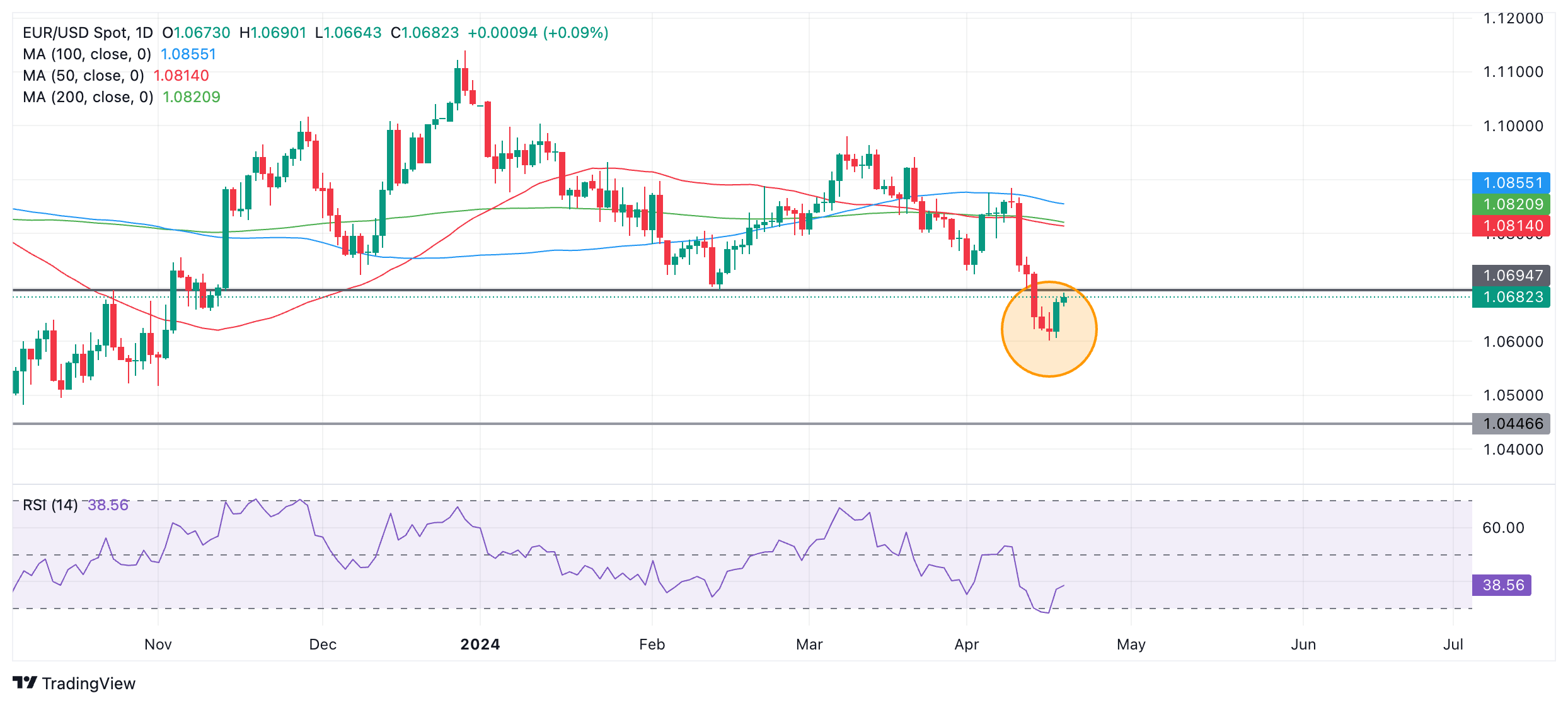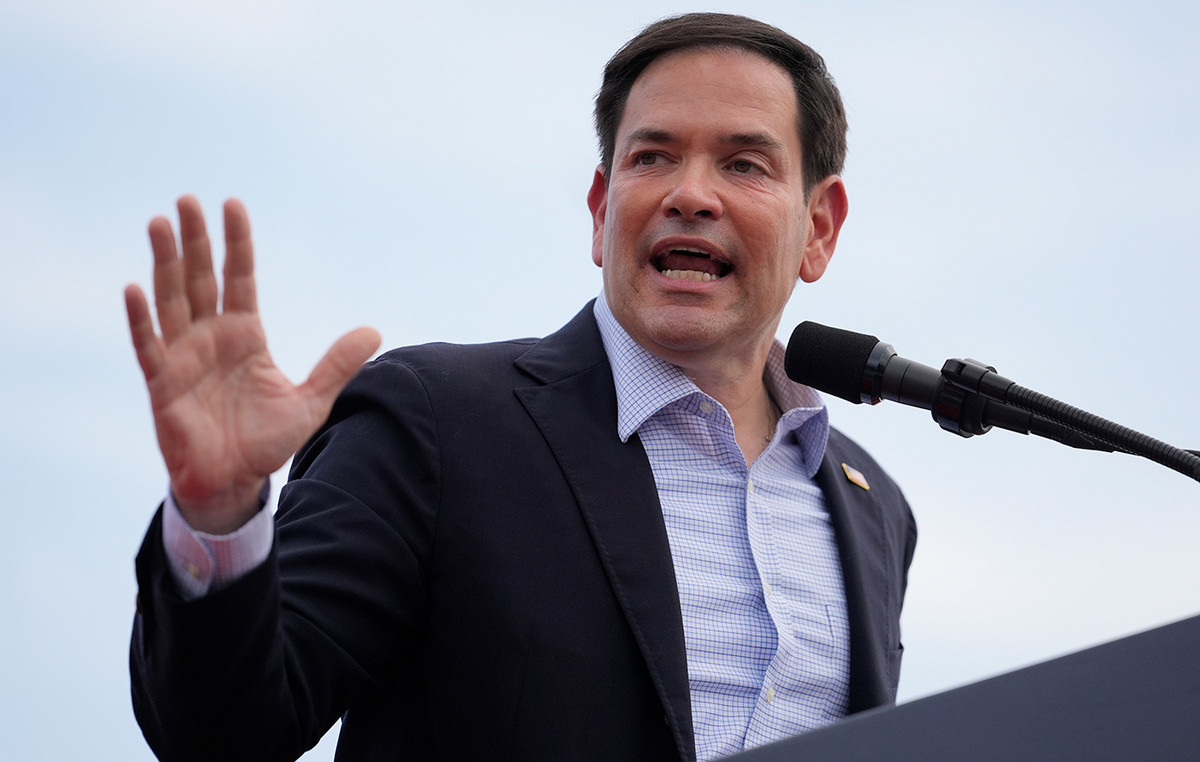- The EUR/USD loses ground after the president of the Bank of France said the ECB should cut at its next meeting.
- The pair had recovered after Lagarde said “the game is not over” on inflation.
- Slow economic growth and stagnant inflation in the Eurozone could weigh on EUR/USD.
- Federal Reserve Chairman Powell talks about keeping rates higher for longer.
EUR/USD trims earlier gains and sinks to 1.0645 on Thursday after Bank of France chief and European Central Bank (ECB) policymaker Francois Villeroy de Galhau said, in a big surprise, that ” should cut interest rates at the next meeting.”
The next meeting is in May and his comments indicate that he, for his part, wants to cut interest rates even before the June meeting, currently marked as the time when most commentators expect the ECB to cut rates. of interest. Lower interest rates tend to depreciate the currency as they reduce foreign capital inflows.
De Galhau said there is a risk that the ECB will be too late to avoid an economic slowdown if it waits too long before lowering interest rates.
“The risk would be to go behind the curve and pay too high a cost in terms of economic activity,” he added.
EUR/USD rebound stalls
The EUR/USD pair shed earlier gains thanks to comments from European Central Bank President Christine Lagarde, who said in a speech in Washington late on Wednesday that “the game (of fighting inflation) ) is not over”, despite adding that “growth in Europe is mediocre, much slower than in the US. We clearly see timid signs of recovery.”
Lagarde's comments introduced a hint of doubt about whether the ECB will really start cutting interest rates in June, as markets believe.
His comment that “growth in Europe is mediocre” echoes the view of currency strategists at Rabobank, who maintain that while there is no risk of a “crisis” in the region, “the combination of slow growth in the Eurozone and persistent budget pressures could lower the Euro's defenses going forward.” Rabobank suggests a drop to 1.0500 is likely, with risks tilted to the downside.
EUR/USD pressured by rumors of longer higher US interest rates
EUR/USD plunged in early April as bets that the Federal Reserve (Fed) would cut interest rates in June quickly moderated amid stronger-than-expected inflation and strong macroeconomic data.
On Tuesday, Federal Reserve Chair Jerome Powell said high interest rates would likely remain in place for longer than expected, given little progress on inflation in recent months.
The Fed's Beige Book, a comprehensive economic study, on Tuesday repeated the view that little progress had been made on inflation, but added that growth and employment were somewhat stronger than expected.
All signs point to the Fed keeping interest rates at their relatively high levels (5.5% upper limit for the federal funds rate) for a while, until the inflation monster is finally brought down.
In fact, CME's FedWatch tool, a market indicator of the likelihood of Fed rate cuts, shows only a 16% chance of a cut in June (down from more than 70% just a few weeks ago), while that the probabilities of a cut in September are now around 70%.
Technical Analysis: EUR/USD embarks on youthful recovery
EUR/USD has done a 180 degree turn after bottoming at 1.0601 on Tuesday. The question now, like most technical questions, is whether this is a trend reversal or simply a pullback in an ongoing downtrend.

EUR/USD Daily Chart
Momentum has been strong in the short time frame of the recovery so far, and the Relative Strength Index (RSI) has broken out of oversold, giving a buy signal – another good sign. However, it is too early to draw conclusions.
The medium-term bearish trend is likely to remain in place and, absent further evidence of a trend reversal, is likely to resume and push the exchange rate down again.
Resistance from the previous lows, around 1.0700, could hamper the recovery and trigger a downward rotation. In any case, this level will offer technical resistance and a support point for the bears, even if their cause is doomed to fail.
A break below the April lows at 1.0601 would mark a lower low and indicate a continuation of the downtrend. After that, the next concrete target is at 1.0446, the October 2023 low.
US Dollar FAQ
What is the US Dollar?
The United States Dollar (USD) is the official currency of the United States of America, and the “de facto” currency of a significant number of other countries where it is in circulation alongside local banknotes. According to 2022 data, it is the most traded currency in the world, with more than 88% of all global currency exchange operations, equivalent to an average of $6.6 trillion in daily transactions.
After World War II, the USD took over from the pound sterling as the world's reserve currency.
How do the decisions of the Federal Reserve affect the Dollar?
The single most important factor influencing the value of the US Dollar is monetary policy, which is determined by the Federal Reserve (Fed). The Fed has two mandates: achieve price stability (control inflation) and promote full employment. Your main tool to achieve these two objectives is to adjust interest rates.
When prices rise too quickly and inflation exceeds the 2% target set by the Fed, the Fed raises rates, which favors the price of the dollar. When Inflation falls below 2% or the unemployment rate is too high, the Fed can lower interest rates, which weighs on the Dollar.
What is Quantitative Easing and how does it influence the Dollar?
In extreme situations, the Federal Reserve can also print more dollars and enact quantitative easing (QE). QE is the process by which the Fed substantially increases the flow of credit into a clogged financial system. This is an unconventional policy measure used when credit has dried up because banks do not lend to each other (for fear of counterparty default). It is a last resort when a simple lowering of interest rates is unlikely to achieve the necessary result. It was the Fed's weapon of choice to combat the credit crunch that occurred during the Great Financial Crisis of 2008. It involves the Fed printing more dollars and using them to buy US government bonds, primarily from financial institutions. QE usually leads to a weakening of the US Dollar.
What is quantitative tightening and how does it influence the US dollar?
Quantitative tightening (QT) is the reverse process by which the Federal Reserve stops purchasing bonds from financial institutions and does not reinvest the principal of maturing portfolio securities in new purchases. It is usually positive for the US dollar.
Source: Fx Street
I am Joshua Winder, a senior-level journalist and editor at World Stock Market. I specialize in covering news related to the stock market and economic trends. With more than 8 years of experience in this field, I have become an expert in financial reporting.







